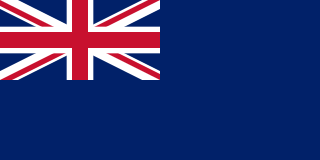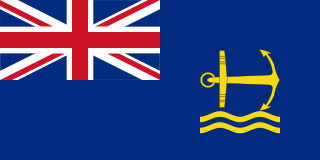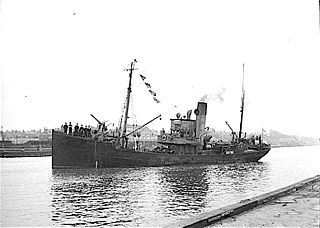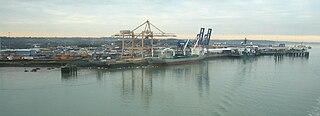
The Blue Ensign is a flag, one of several British ensigns, used by certain organisations or territories associated or formerly associated with the United Kingdom. It is used either plain or defaced with a badge or other emblem.

The Royal Maritime Auxiliary Service(RMAS) was a British Government agency which ran a variety of auxiliary vessels for His Majesty's Naval Service (incl. Royal Navy, Royal Marines) and the Royal Fleet Auxiliary. The service from 2009 has been run by Serco and is known as Serco Marine Services.
The Sea Fencibles were naval fencible units established to provide a close-in line of defence and obstruct the operation of enemy shipping, principally during the French Revolutionary and Napoleonic Wars.

His Majesty's Naval Service is the United Kingdom's naval warfare and maritime service. It consists of the Royal Navy, Royal Marines, Royal Fleet Auxiliary, Royal Naval Reserve, Royal Marines Reserve and Naval Careers Service. The term Naval Service should be distinguished from the "UK Naval Services", which consist of the Naval Service and the Merchant Navy. The Naval Service as a whole falls under the command of the Navy Board, which is headed by the First Sea Lord. This position is currently held by Admiral Sir Ben Key. The Defence Council delegates administration of the Naval Service to the Admiralty Board, chaired by the Secretary of State for Defence.

The Royal Naval Auxiliary Service (RNXS) was a uniformed, unarmed, civilian volunteer service, administered and trained by the Royal Navy to operate in the ports and anchorages of the United Kingdom in an emergency. Although the abbreviated title would logically have been RNAS this abbreviation had long been taken by the various Royal Naval Air Stations, so RNXS it was. It maintained training units, and vessels at most major ports in the UK. and was formed in 1963 from the amalgamation of the Royal Naval Mine-watching Service (RNMWS) and Admiralty Ferry Crew Association in response to the perceived nuclear threat to British ports. The service was disbanded on 31 March 1994 due to Ministry of Defence (MOD) cuts. Most vessels from its fleet were transferred to the Royal Navy or sold, with the exception of XSV Loyal Volunteer, which was struck by a ro-ro ferry while berthed in Ipswich Harbour and was later scrapped.

A landing ship, infantry (LSI) or infantry landing ship was one of a number of types of British Commonwealth vessels used to transport landing craft and troops engaged in amphibious warfare during the Second World War. LSIs were operated by the Royal Navy, British Merchant Navy, Royal Canadian Navy, Royal Indian Navy, and Royal Australian Navy. They transported British Commonwealth and other Allied troops in sea assaults and invasions throughout the war.

HMS Example is an Archer-class patrol and training vessel of the Royal Navy, based at HMS Calliope in Gateshead, England. Example was originally built for the Royal Naval Auxiliary Service, and was transferred to the Royal Navy when the RNXS disbanded in 1994. On transfer, she retained her name, and became the first ship in the Royal Navy to bear that name.

The Royal Naval Mine Watching Service was a civilian organisation formed in 1952 as part of the auxiliary forces of the British Naval Service.
HMS Exploit is an Archer-class patrol vessel of the British Royal Navy, built in Woolston by Vosper Thornycroft and commissioned in 1988. She is assigned to the Royal Navy Coastal Forces Squadron, carrying out a range of activities both in the U.K. and overseas.

HMCS York is a Royal Canadian Navy Reserve Division (NRD) located in Toronto, Ontario. Dubbed a stone frigate, HMCS York is a land-based naval establishment for part-time sailors as well as a local recruitment centre for the Canadian Naval Reserve.

The Archer class is a class of patrol and training vessel in service with the United Kingdom's Royal Navy, commonly referred to as a Fast Training Boat. Most are assigned to Coastal Forces Squadron. HMS Tracker and HMS Raider are armed and provide maritime force protection to high value shipping in the Firth of Clyde and are most commonly employed as escorts for submarines transiting to Faslane. Pursuer and Dasher were also armed during their deployment on maritime force protection duties with the Gibraltar Squadron from 2020-2022.

The Castle-class minesweeper was a highly seaworthy naval trawler adapted for patrol, anti-submarine warfare and minesweeping duties and built to Admiralty specifications. Altogether 197 were built in the United Kingdom between 1916 and 1919, with others built in Canada, India and later New Zealand. Many saw service in the Second World War.

An armed yacht was a yacht that was armed with weapons and was typically in the service of a navy. The word "yacht" was originally applied to small, fast and agile naval vessels suited to piracy and to employment by navies and coast guards against smugglers and pirates. Vessels of this type were adapted to racing by wealthy owners. The origin of civilian yachts as naval vessels, with their speed and maneuverability, made them useful for adaptation to their original function as patrol vessels. In the United States Navy armed yachts were typically private yachts expropriated for government use in times of war. Armed yachts served as patrol vessels during the Spanish–American War and the World Wars. In the latter conflicts, armed yachts were used as patrol vessels, convoy escorts, and in anti-submarine duties. In the United States, yachts were purchased from their owners with the owners given an option to repurchase their yacht at the close of hostilities.

The German Mine Sweeping Administration (GMSA) was an organisation formed by the Allies from former crews and vessels of the Nazi Germany's Kriegsmarine for the purpose of mine sweeping after the Second World War, predominantly in the North Sea and Baltic Sea, which existed from June 1945 to January 1948.

HMS Badger was a shore establishment of the Royal Navy on the east coast of the United Kingdom. She was commissioned on 13 September 1939 was the flagship of the headquarters of the Flag Officer in Charge (FOIC), Harwich who was responsible to Commander-in-Chief, The Nore, and was decommissioned on 21 October 1946, although the Operations Room remained as the Emergency Port Control for the Harwich area. The site was Parkeston Quay, now Harwich International Port, and the bunker lies under Hamilton House, currently an occupational health centre, close to the entrance to Harwich International Port, a few miles west of Harwich.

The Maritime Volunteer Service (MVS) is a United Kingdom wide charity, which has as its motto: "Supporting YOUR Community with OUR People".

Serco Marine Services is a Private Finance Initiative contract, with Serco Group, to deliver auxiliary services to His Majesty's Naval Service.

HMS Castle Harbour was a civilian harbour vessel of 730 tons that was taken-up from trade (TUFT) during the Second World War by the Royal Naval Dockyard in Bermuda for use by the Royal Naval Examination Service and later armed and commissioned as a warship, providing harbour defence from submarines.

Canadian Forces Auxiliary Vessel (CFAV) Grizzly was one of ten wooden YAG 300 vessels built for the Royal Canadian Navy (RCN) between 1953 and 1955. Built for use as auxiliary craft, Grizzly primarily served as an at-sea training platform for junior naval officers, boatswains, reserve personnel and Sea Cadets at Canadian Forces Base (CFB) Esquimalt. Her name perpetuated the WWII armed yacht HMCS Grizzly was reused for PTC 60 GrizzlyOrca-class Patrol Craft Training (PCT) tender that replaced the YAG 300 vessels as the RCN training tenders in 2008.
The Ceylon Royal Naval Volunteer Reserve was the volunteer naval reserve of the British Crown colony of Ceylon from 1938 to 1950. Established as the Ceylon Naval Volunteer Force (CNVF) on 1 January 1938 under the Naval Volunteer Ordinance, No, l of 1937. It was made up of volunteers mainly from the mercantile sector of Colombo consisting of 12 officers and 18 sailors, under the command of the newly commissioned Commander W. G. Beauchamp. The first headquarters of the force was set up on 11 January 1939, just before the outbreak of World War II, at Kochchikade.















